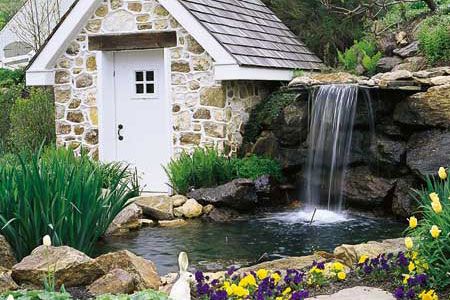A backyard pond can transform your outdoor space into a serene oasis, offering stunning views and a soothing ambiance. Whether you are considering a small goldfish pond for your patio or a more prominent water feature with a waterfall, installing a pond can significantly enhance your property’s look and value.
Serene Pond Scenes
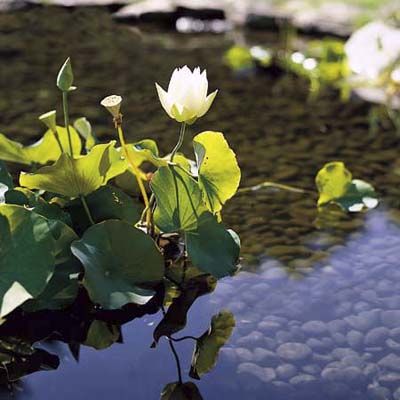
Ponds offer numerous benefits to homeowners. They can increase property value, provide a relaxing atmosphere, and even help support local wildlife. While you should consider the initial cost and ongoing maintenance, many find the rewards of having a backyard pond worth the investment.
Planning and Budgeting for a Pond
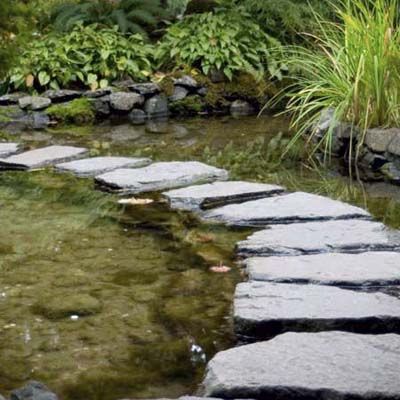
When considering a pond installation, look beyond the initial costs and factor in ongoing maintenance expenses. Additional elements such as plants, fish, decorative stones, streams, waterfalls, and fountains can quickly add up. In some areas, local regulations may require fencing for ponds over a certain depth.
Remember that a pond is a permanent feature in your landscape, so careful planning is important to make sure it complements your home and property. Consider consulting a landscaping professional or garden center expert with experience in pond installation to help with design and placement.
When budgeting for your pond, consider the following factors:
- Size and depth of the pond
- Type of liner or pre-formed shell
- Filtration and pumping systems
- Landscaping materials (rocks, plants, etc.)
- Additional features (waterfalls, fountains, lighting)
- Potential fencing or safety measures
- Ongoing maintenance costs (electricity, water treatments, etc.)
Additionally, you should account for seasonal variations in maintenance costs. Depending on your climate, you may need to invest in pond heaters, protective covers, or additional water treatments to keep your pond in optimal condition throughout the year.
Flexible-Lined vs. Pre-Molded Fiberglass Ponds
The two most popular choices for homeowners are flexible-lined and pre-molded fiberglass ponds, which offer relatively straightforward installation processes. Flexible-lined ponds provide greater versatility in size and shape, allowing you to create a more naturalistic look. These often come in kit form, with liner, pump, filters, and installation instructions.
To construct a liner pond, you’ll need to excavate the desired area by hand or with a backhoe. After digging, add a cushioning layer of clay and sand and a protective pond fabric to safeguard the liner from punctures. Finally, surround the edges with rocks or landscape plants to seamlessly transition to the surrounding environment.
Pre-molded fiberglass ponds often offer a more accessible installation alternative, as they come in standardized shapes and sizes. Simply dig a hole to match the shape of the pre-molded form, place the form in the hole, and fill in the gaps with soil or sand. You can customize both types of ponds with additional features like waterfalls, fountains, and decorative lighting to enhance their appeal.
Basic Pond Styles
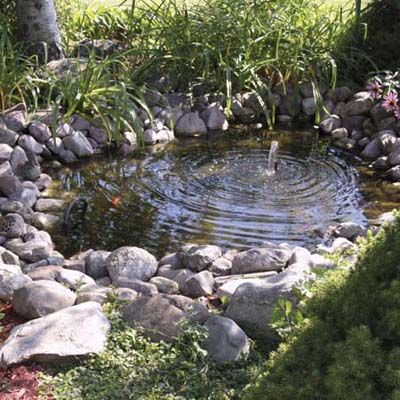
Ponds come in various shapes, sizes, and styles to suit different preferences and landscapes. From expansive, free-form bodies of water suitable for swimming or fishing to formal reflecting pools, the options are nearly endless. Prices for pond installation can vary significantly, ranging from $300 to $11,000.* Larger versions, like a 16-by-21-square-foot pond, can cost upwards of $25,000.
*Cost data in this article sourced from contractor estimates used by Angi.
Wading Pond
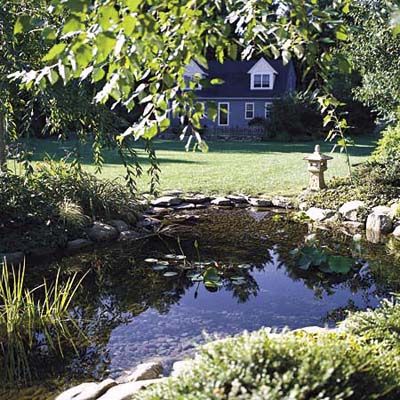
A wading pond can be a captivating centerpiece for your front or backyard garden. This type of pond is shallow enough for gentle wading while providing a home for aquatic plants and small fish. Consider incorporating elements that blend seamlessly with your landscape when designing a wading pond.
In this example, flat coping stones salvaged from an old stone wall create a natural-looking border around the pond. The construction process to create a similar pond will involve several steps:
- Excavate using a backhoe to create the desired shape and depth.
- Back-fill with clay and sand to form shelves for potted aquatic plants.
- Add a protective fabric layer to prevent punctures.
- Install a flexible pond liner.
- Place smooth river stones on top of the liner for added protection.
This pond design allows for various plantings, including irises, lotus, and water lilies. The shallow depth and easy access make it an ideal spot for family members and pets to cool off on hot days. When planning your wading pond, consider incorporating similar features to create a multi-functional and visually appealing water feature.
Additionally, incorporating stepping stones around the pond’s perimeter can enhance accessibility and add a decorative touch. These can be interspersed with low-growing ground cover plants to create a cohesive and natural look. Using native plants around the pond can attract local wildlife, such as birds and butterflies, further enhancing the ecosystem.
Formal Pool
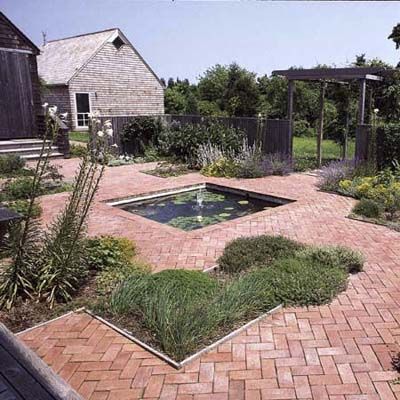
A formal pool with clean edges and a concrete lining can be perfect for a structured landscape design, such as a brick-paved herb garden or a symmetrical patio area. This type of pond offers a more architectural look that complements modern or traditional home styles.
The construction of a formal pool typically involves the following steps:
- Excavate the desired shape and depth (in this case, an 8-foot-square-by-4-foot-deep hole).
- Install wooden forms reinforced with rebar.
- Pour concrete to create a durable, watertight lining.
- Install a drain to prevent overflow.
- Add waterproof electrical connections for pumps and fountains.
Consider adding potted aquatic plants like water lilies and introducing goldfish for a pop of color and movement. The combination of plants, fish, and an aerating fountain can create a self-sustaining ecosystem that requires minimal maintenance over time.
In this example, after 18 years of operation, the pond no longer needs annual cleaning, demonstrating the long-term benefits of a well-designed and balanced aquatic environment. When planning your formal pool, consider incorporating similar elements to create a low-maintenance, visually striking water feature that will stand the test of time.
Lighting can also significantly accent a formal pool, especially for evening enjoyment. Consider adding underwater or strategically placed garden lights around the pool to highlight its clean lines and create a mesmerizing effect you can enjoy day and night.
Pathway Pond
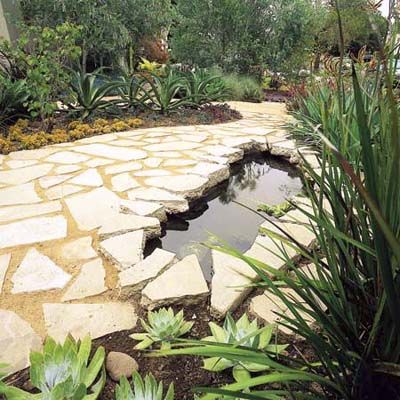
A pathway pond is an innovative way to incorporate a water feature into a small space, adding an unexpected decorative touch to your front walkway or garden path. These ponds are typically narrow and shallow, making them an excellent option for those with limited outdoor space or those looking to create a unique focal point in their landscape design.
In this example, the front-walk pond measures just 2 by 5 feet and is 18 inches deep. The construction process for this type of pond is relatively simple:
- Hand-dig the desired shape and depth.
- Line the excavation with mosaic tiles set in concrete for a decorative finish.
- Install a tiny pump and connect it to existing electrical outlets in the garden.
- Bury the power cord under the walkway for a clean, seamless look.
One of the advantages of a small pathway pond is its low maintenance requirements. With few or no fish and minimal plants, this pond typically only needs occasional pump filter cleaning every two months.
Consider the following elements:
- Choose a location that complements your existing walkway or garden path
- Select decorative materials that match or enhance your home’s exterior
- Incorporate low-maintenance aquatic plants for added visual interest
- Install subtle lighting to create a magical nighttime ambiance
In addition, consider adding a small bench or seating area near the pathway pond to create a cozy spot for relaxation and contemplation. The sound of trickling water can provide a calming ambiance, making it a favorite place for enjoying your garden. Seasonal decorations or holiday-themed elements can further personalize the space, making it a dynamic and cherished part of your home.
Falling Water
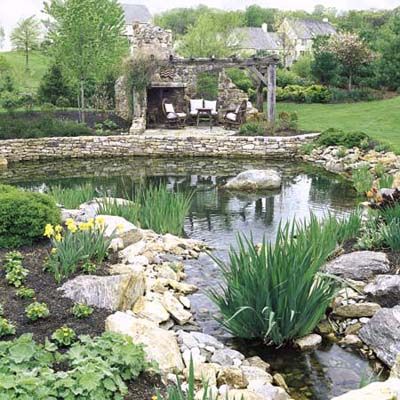
A multi-level pond with a waterfall can create a stunning focal point in your landscape, providing visual interest and the soothing sound of falling water. A falling water pond design typically consists of two or more interconnected bodies of water at different elevations, allowing water to cascade from one level to the next.
In this example, the free-form pond is built on two levels and holds an impressive 30,000 gallons of water. The key features of this design include:
- A top-level “header” pond that serves as the water source for the waterfall
- A stone-lined spillway that guides water from the upper pond to the lower pond
- A lower pond that collects the falling water
- A pump system that recirculates water from the lower pond back to the header pond
Consider the following factors:
- Proper grading so that water flows in the desired direction
- Strategic placement of rocks and plants to create a natural-looking waterfall
- Adequate pump capacity to maintain consistent water flow
- Incorporation of a stone retaining wall to prevent overflow and flooding in adjacent areas
To manage rainwater runoff, you can excavate soil from the pond construction to create banked areas around the pond and flower beds. This helps with water management and adds dimension and interest to the landscape.
Consider incorporating different textures and heights around the waterfall’s planting design to enhance its natural appearance. Arrange plants like ferns, hostas, and water irises strategically to soften the hard edges of stones and create a lush, cascading effect that mirrors the water’s flow. Adding small, submerged lights within the waterfall can further emphasize the water movement, creating a captivating visual display during the evening hours.
Personalizing Your Pond
Ponds create an eye-catching focal point in your landscape and provide a habitat for various aquatic plants and animals. Below, we’ll cover some additions you can consider to put your own flair on your outdoor oasis.
Pondside Storage
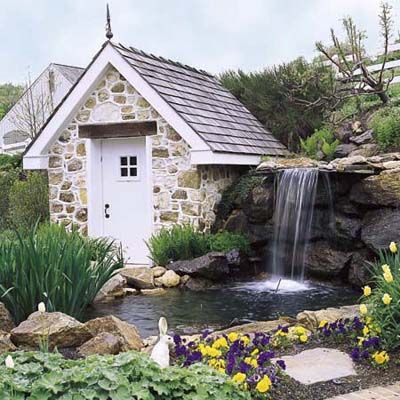
Incorporating functional storage solutions near your pond can enhance visuals and practicality. A well-designed storage area, such as a spring house or garden shed, can provide a convenient place to store pond maintenance equipment, gardening tools, and other outdoor essentials while complementing the overall landscape design.
In this example, a spring house is an attractive and functional storage solution near the pond. When planning a similar feature for your pond area, consider the following:
- Choose a design that complements your home’s architecture and the pond’s style
- Provide easy access to the storage area for convenience in pond maintenance
- Incorporate windows or skylights to allow natural light into the storage space
- Use weather-resistant materials to protect stored items from moisture and the elements
Consider these landscaping techniques:
- Group rocks of varying sizes around the pond’s perimeter and within the water
- Plant native aquatic and marginal plants to create a seamless transition between land and water
- Use a mix of evergreen and deciduous plants to provide year-round interest
We recommend regular maintenance to keep your pond and surrounding area in top condition. For this pond setup, clean pump filters every six weeks to prevent sediment buildup, and drain and clean the ponds every four years.
A small seating area near the pondside storage can enhance functionality and enjoyment. Benches or chairs allow you to rest and appreciate your pond after performing maintenance tasks. Integrated planters or trellises near the storage area can add vertical interest and create a cohesive, well-integrated look.
Koi Fish
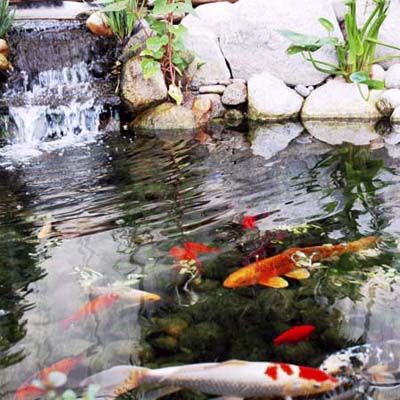
Koi fish are a popular addition to ornamental ponds, adding vibrant colors and graceful movement to your water feature. These elegant fish and various types of goldfish require minimal care beyond daily feeding, making them an excellent choice for pond enthusiasts of all experience levels.
When planning a koi pond, consider the following factors:
- Location: Choose a spot with a balance of sun and shade, away from deciduous trees, to prevent fallen leaves from decomposing in the water.
- Water quality: Avoid areas with potential rain runoff that could introduce fertilizers or yard debris into the pond.
- Size: Provide adequate space for your fish. Small goldfish need 2 to 10 gallons of water each, while larger koi require 500 gallons or more per fish.
- Depth: For fish to overwinter safely beneath ice, the pond should be at least 36 inches deep.
- Water chemistry: Regularly test and verify proper chemical balance to maintain a healthy environment for fish and plants.
Try to incorporate these elements:
- A variety of aquatic plants provide oxygen and natural filtration
- Adequate filtration systems to maintain water quality
- Shaded areas or deeper sections for fish to retreat from heat or predators
- Smooth-edged rocks and gravel to prevent injury to fish
Consider including floating feeding rings to confine food to one pond area, which helps all fish feed comfortably. Automated feeders provide consistent feeding schedules, which can be particularly useful if you have a busy lifestyle or travel frequently. Additionally, you can train koi to feed from your hand, adding an extra layer of interaction and enjoyment to your pond experience.
Plants
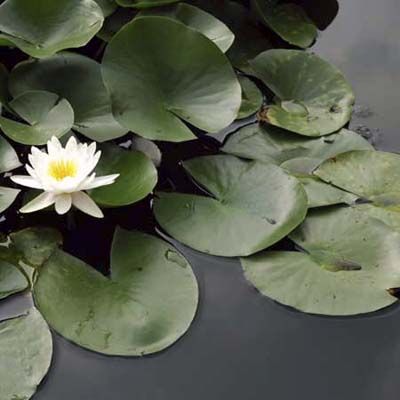
Incorporating aquatic plants into your pond enhances beauty and plays an important role in maintaining a healthy ecosystem. Plants help keep the water clean by controlling algae growth and providing oxygen for fish and other aquatic life. When selecting plants for your pond, consider a variety of species that serve different functions and add visual interest at various water levels.
Some popular types of pond plants include:
- Oxygenating plants: These grow entirely underwater and consume nutrients that would otherwise feed algae. Examples include elodea (anacharis) and hornwort.
- Floating plants: Species like water hyacinth and water lettuce drift on the surface, providing shade that inhibits algae growth and creating a natural look.
- Marginal plants: These grow along the pond’s edges, helping to integrate it with the surrounding landscape. Examples include cattails, iris, and rushes.
- Deep-water plants: Water lilies and lotus are classic choices that add beauty and provide shade for fish.
When adding plants to your pond, keep these tips in mind:
- Use pots for easy maintenance and to control plant growth, especially if your pond has a lined bottom
- Choose a mix of hardy and tropical plants to promote year-round interest
- Remove non-hardy plants before winter to prevent decomposition in the pond
- Research each plant’s growth habits to confirm they won’t overtake your pond
Incorporating marginal plants with diverse heights and textures can enhance the pond’s natural appearance and provide a habitat for various wildlife. Seasonal plants can guarantee that something is always in bloom, offering visual interest throughout the year. Succulents and other drought-tolerant plants can be placed alongside the pond’s edge, creating a harmonious transition between the water and the surrounding landscape.
Ongoing Pond Maintenance
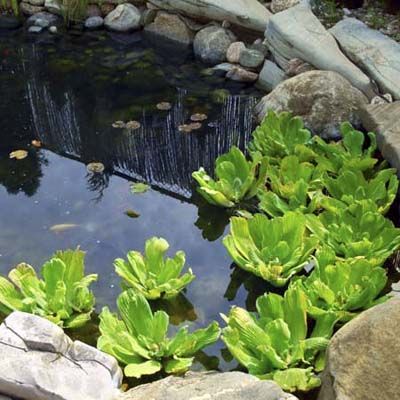
Proper maintenance is necessary for keeping your pond healthy, clean, and visually appealing. While the specific care requirements may vary depending on the size and complexity of your pond, several general maintenance tasks apply to most water features.
Key aspects of pond maintenance include:
- Filtration system care: Clean or replace filters regularly for efficient water circulation and debris removal.
- Water quality management: Test and adjust water chemistry to maintain a healthy environment for plants and fish.
- Algae control: Remove excess algae manually or use appropriate treatments to prevent overgrowth.
- Plant care: Trim and divide aquatic plants to prevent overcrowding and maintain their health.
- Seasonal preparations: Adjust maintenance routines based on seasonal changes, such as preparing for winter or spring startup.
Consider the following maintenance schedule:
- Daily: Remove any visible debris from the water surface and check for signs of fish distress.
- Weekly: Test water quality and make necessary adjustments.
- Monthly: Clean pump and filter components and trim plants as needed.
- Seasonally: Perform more thorough cleanings and prepare for seasonal changes.
- Annually: Drain and clean the entire pond, typically every three to 5 years, depending on its size and condition.
Additional equipment that can help maintain your pond includes:
- UV lights to control harmful bacteria
- Heaters to prevent surface freezing in colder climates
- Pool vacuums for removing settled debris
- Winter covers to protect the pond during harsh weather
In addition, consider setting reminders for routine checks and tasks to streamline the maintenance process. Pre-scheduled services from pond maintenance companies are also an option if you prefer professional care. Installing motion-detection lights near the pond can deter nocturnal predators and keep your pond safe for fish and plants.
Our Conclusion
By considering pond style, size, location, and plant selection, you can create a stunning and sustainable aquatic environment that enhances your property’s value and enjoyment of the outdoors.
